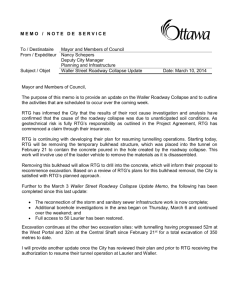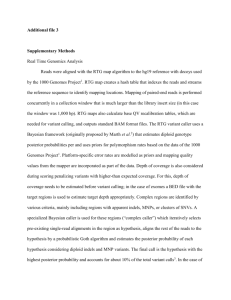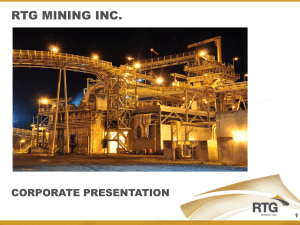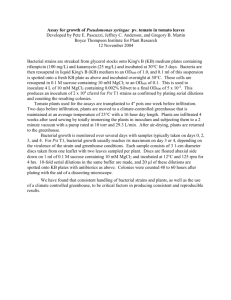electronic supplementary material An environmental and economic
advertisement
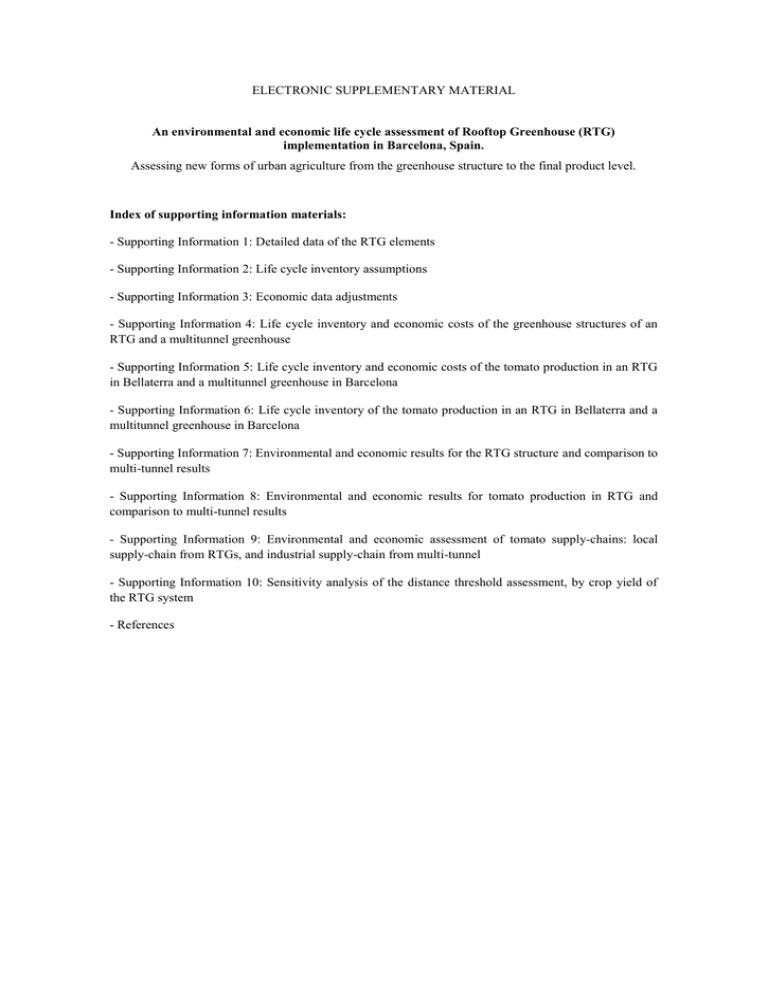
ELECTRONIC SUPPLEMENTARY MATERIAL An environmental and economic life cycle assessment of Rooftop Greenhouse (RTG) implementation in Barcelona, Spain. Assessing new forms of urban agriculture from the greenhouse structure to the final product level. Index of supporting information materials: - Supporting Information 1: Detailed data of the RTG elements - Supporting Information 2: Life cycle inventory assumptions - Supporting Information 3: Economic data adjustments - Supporting Information 4: Life cycle inventory and economic costs of the greenhouse structures of an RTG and a multitunnel greenhouse - Supporting Information 5: Life cycle inventory and economic costs of the tomato production in an RTG in Bellaterra and a multitunnel greenhouse in Barcelona - Supporting Information 6: Life cycle inventory of the tomato production in an RTG in Bellaterra and a multitunnel greenhouse in Barcelona - Supporting Information 7: Environmental and economic results for the RTG structure and comparison to multi-tunnel results - Supporting Information 8: Environmental and economic results for tomato production in RTG and comparison to multi-tunnel results - Supporting Information 9: Environmental and economic assessment of tomato supply-chains: local supply-chain from RTGs, and industrial supply-chain from multi-tunnel - Supporting Information 10: Sensitivity analysis of the distance threshold assessment, by crop yield of the RTG system - References Supporting Information 1: Detailed data of the RTG elements The following figure shows the elements that form the rooftop greenhouse. The table compiles data of the different rooftop greenhouse elements: material, lifespan and maintenance needs to fulfil building’s lifespan (50 years). The lifespan of the element corresponds to producers’ data and engineers’ designs. Nº 1 2 3 4 5 6 7 8 9 10 11 12 13 Element Anchor Concrete anchor Bolt Structure Pillar Pillar complements Bracing tubes Chapel Straps Gutters Exterior gutter Interior gutter Walls Roll wall Covering Windows Frame Climate screen Climate screen Material Lifespan [y.] Maintenance [nº changes] Concrete Steel (85% R) 50 50 - Steel (85% R) Steel (85% R) Steel (85% R) Steel (85% R) Steel (85% R) 50 50 50 50 50 - Steel (85% R) Steel (85% R) 50 50 - 3-layer LDPE 4 12.5 Polycarbonate Steel (85% R) 10 50 5 - Polyester-Aluminum 5 10 Supporting Information 2: Life cycle inventory assumptions Materials transportation: The transportation requirements of the materials were calculated according to the production site of each one. The following table compiles the origin, the distance, and the mode of transportation for each material of the RTG structure. Material Steel Polycarbonate Origin Martorell, Spain Doncaster, UK Polyethylene Concrete Climate screen Tarragona, Spain Barcelona, Spain Hellevoetsluis, The Netherlands Distance (km) 77 1008.44 991.7 101 40 1487 Mode of transportation Lorry 16-32t, EURO5 Transoceanic freight ship Lorry 16-32t, EURO5 Lorry 16-32t, EURO5 Lorry 16-32t, EURO5 Lorry 16-32t, EURO5 Technical data of machinery used in the construction stage: Two machineries were used in the construction of the rooftop greenhouse. On the one hand, a tower crane raised the materials and construction elements to the rooftop. On the other hand, the greenhouse was built by using a scissor platform. Both machineries are electric and their consumption was calculated based on the following technical specifications and on the weight of the amount of materials of the RTG. Characteristics Brand, model Load capacity Power Rise Descent Speed Rise Descent Tower crane Liebherr 90LD 1300 kg 22 kW 3.8 kW 56 m/min Scissor platform Haulotte compact8 230 kg 4.44 kW 0.76 kW 41 s 37 s Supporting Information 3: Economic data adjustments The economic costs were collected from different years, based on the available studies. However, 2013 was chosen as the reference year since the RTG was built in that period. To update costs from the collection year to the reference one, the present value was calculated for each cost according to the inflation rate. The present value (PV) formula used for the calculations was: 𝑃𝑉 = 𝐶𝑖 (1+𝑟) Where Ci is the cost at the year i, and r is the inflation rate value for the corresponding year. The inflation rate for the period under assessment was obtained for Spain (IMF). Year Year number (i) 2008 2009 2010 2011 2012 2013 0 1 2 3 4 5 Inflation rate (end of period) 1.455 0.893 2.861 2.356 2.998 0.305 The collection year for the costs related to each stage and system are listed below. Value Greenhouse structure cost Crop inputs cost Electricity cost Packaging cost Distribution transportation cost Tomato producer price (Euphoros) Tomato wholesale price Tomato consumer price RTG system 2013 2008 2013 2011 2012 2008 2009 2013 Multitunnel system 2008 2008 2013 2011 2012 2008 2009 2013 Supporting Information 4: Life cycle inventory and economic costs of the greenhouse structures of an RTG and a multitunnel greenhouse Life cycle inventory: The following table displays the life cycle inventory of the greenhouse structure of the RTG on the ICTA-ICP building and the multi-tunnel greenhouse structure in Almeria. RTG data is obtained from the architectural project, or calculated. Multitunnel data is entirely obtained from the Euphoros project (Montero et al. 2011), which included the maintenance requirements in the materials stage. The LCI refers to the functional unit of 1 m2 of a greenhouse structure for a timeframe of 1 year. Life cycle stage Input Unit Materials Steel (100% recycled) Concrete LDPE Polycarbonate Polyester Aluminium Polypropylene PVC Lorry 35-40t EURO5 Transoceanic freight ship Machinery use LDPE Polycarbonate Polyester Aluminium Lorry 35-40t EURO5 Transoceanic freight ship Recycling process Transport, lorry 16-32t kg kg kg kg kg kg kg kg tkm tkm kWh kg kg kg kg tkm tkm kg tkm Construction Maintenance End of life RTG Per m2 0.836 0.212 0.006 0.032 0.0008 0.0008 0.124 0.032 0.0004 0.072 0.128 0.007 0.007 0.154 0.129 1.302 0.046 Source Project data Project data Project data Project data Project data Project data Calculation Calculation Calculated Project data Project data Project data Project data Calculation Calculation Project data Calculated Multitunnel Per m2 0.513 0.505 0.159 0.011 0,021 0,012 0.438 1,188 - Economic costs: The following table compiles the economic costs of the Rooftop Greenhouse of the RTG-Lab according to project data. For materials, cost data is cradle-to-construction site, including: material extraction, material processing, labour, and transportation. Data corresponds to the functional unit of 1m2 and 1 year. Regarding the multi-tunnel greenhouse, the EUPHOROS project (Montero et al. 2011) only showed the global costs of the infrastructure: 3.84€·m-2·year-1. Life cycle stage Materials Construction Maintenance Waste management TOTAL COST Input Steel Concrete LDPE Polycarbonate Climate screen Machinery use Labour LDPE Polycarbonate Climate screen Transport, lorry 16-32t RTG [€/m2] 3.12 0.005 0.26 1.06 0.56 0.00 0.324 0.39 1.06 5.05 0.006 11.9 Supporting Information 5: Life cycle inventory and economic costs of the tomato production in an RTG in Bellaterra and a multitunnel greenhouse in Barcelona Life cycle inventory: The following table displays the life cycle inventory of the tomato production in the RTG of the ICTA-ICP building (Bellaterra) and a multi-tunnel greenhouse structure in Almeria. RTG data is obtained from the architectural project, adapted from the Euphoros project (Montero et al. 2011), or calculated. Multitunnel data is entirely obtained from the Euphoros project (Montero et al. 2011). Input Greenhouse structure Steel (100% recycled) Concrete LDPE Polycarbonate Polyester Aluminium PVC Lorry 35-40t EURO5 Transoceanic freight ship Machinery use Lorry 35-40t EURO5 Recycling process Auxiliary equipment LDPE Polystyrene HDPE PVC Steel (100% recycled) Expanded perlite Van, <3.5t Inputs consumption Water (rainwater) Water (groundwater) Electricity Fertilizer (N) Fertilizer (P2O5) Fertilizer (K2O) Pesticides Waste management Recycling process Final disposal Transport, van <3.5t Transport, lorry 7.5t RTG Unit Per m2 Per kg Source kg kg kg kg kg kg Kg tkm tkm kWh tkm kg 8,36E-01 2,12E-01 7,80E-02 1,60E-01 7,80E-03 7,80E-03 2,78E-01 1,61E-01 4,00E-04 1,30E+00 4,60E-02 3,34E-02 8,48E-03 3,12E-03 6,40E-03 3,12E-04 3,12E-04 1,11E-02 6,44E-03 1,60E-05 5,21E-02 1,84E-03 Project data Project data Project data Project data Project data Project data Calculation Calculation Calculation Calculation Project data 5,13E-01 5,05E-01 1,59E-01 1,10E-02 1,20E-02 4,38E-01 - 3,11E-02 3,06E-02 9,64E-03 6,67E-04 7,27E-04 2,65E-02 - kg kg kg kg kg kg tkm 2,30E-02 2,60E-02 9,40E-03 4,40E-03 5,00E-04 6,20E-01 2,00E-04 9,20E-04 Montero 1,04E-03 et al. (2011) 3,76E-04 1,76E-04 2,00E-05 2,48E-02 8,00E-06 2,30E-02 2,60E-02 9,40E-03 4,40E-03 5,00E-04 6,20E-01 2,00E-04 1,39E-03 1,58E-03 5,70E-04 2,67E-04 3,03E-05 3,76E-02 1,21E-05 m3 m3 kWh g g g g 7,97E-01 3,19E-02 Calculated 1,08E+00 9,76E+02 6,18E+01 1,91E+01 4,00E+00 4,32E-02 Adapt. 3,90E+01 Montero 2,47E+00 et al. (2011) 7,64E-01 1,60E-01 4,74E-01 6,36E-01 7,99E+02 5,06E+01 1,56E+01 3,27E+00 2,87E-02 3,85E-02 4,84E+01 3,06E+00 9,47E-01 1,98E-01 kg kg tkm tkm 6,83E-01 1,32E-01 - 2,73E-02 5,28E-03 - 3,41E-01 3,42E-01 2,20E-02 5,00E-03 2,07E-02 2,07E-02 1,33E-03 3,03E-04 Calculated Calculated - Multitunnel Per m2 Per kg - Economic costs: The following table shows the economic costs related to the tomato production in an RTG (Bellaterra) and in a multi-tunnel greenhouse (Almeria). Results are shown per area and per kg of product. Multitunnel data is entirely obtained from the Euphoros project (Montero et al. 2011). Input Greenhouse structure Auxiliary equipment Water Electricity Fertilizers Pesticides Paid labour TOTAL COST RTG Per m2 11,9 1,51 0 0,391 0,814 0,475 3,337 18.43 Per kg 0,476 0,0604 0 0,01564 0,03256 0,019 0,13348 0.737 Source Project Montero et al. (2011) Calculated Adapted from Montero et al. (2011) Multitunnel Per m2 Per kg 4,26 0,258 1,51 0,092 0,222 0,013 0,233 0,014 0,666 0,040 0,389 0,024 2,731 0,166 10.01 0.607 Supporting Information 6: Life cycle inventory of the tomato production in an RTG in Bellaterra and a multitunnel greenhouse in Barcelona The following table displays the life cycle inventory of the local supply-chain of tomatoes produced in an RTG in Bellaterra and consumed in Barcelona, and of the industrial supply-chain of tomatoes produced in a multi-tunnel greenhouse in Almeria and consumed in Barcelona. The functional unit of the inventory is 1 kg of tomato at the consumer. The inventory of the multi-tunnel system is based on Sanyé-Mengual et al. (2013). Life cycle stage Agriculture production Packaging production Distribution Retail Input Tomato produced HDPE tray Transportation, lorry 5t Transportation, lorry 45t Distribution centre Transportation, van 3.5t Loss of product Unit kg kg km km kWh km kg RTG 1 0.1 25 0 Multi-tunnel 1.166 0.1166 20 825 0.743·10-3 10 0.1 Economic costs: The following table compiles the costs of the supply-chain of tomatoes in the RTG and the multi-tunnel scenario. Life cycle stage Agriculture production Packaging production Distribution Retail TOTAL Input RTG [€] Tomato produced 0.752 HDPE tray 0.105 Transportation, lorry 5t Transportation, lorry 45t Distribution centre Transportation, van 3.5t 0.006 Loss of product 0.863 Multi-tunnel [€] 0.643 0.119 0.005 0.0644 0.001 0.003 0.147 0.982 Supporting Information 7: Life cycle impact assessment results for the RTG structure and comparison to multi-tunnel results The following figure details the distribution of the environmental burdens of 1 m 2 of the RTG structure for a timeframe of 1 year. The contribution of the different life cycle stages is shown in the cradle-to-grave figure, while the contribution of the materials is reported for the materials [blue graph] and for the maintenance [green graph] life cycle stages. *Global Warming Potential (GWP), Ozone depletion (OD), Human toxicity (HT), Photochemical oxidant formation (POF), Particulate matter formation (PMF), Ionising radiation (IR), Terrestrial acidification (TA), Freshwater eutrophication (FE), Marine eutrophication (ME), Terrestrial ecotoxicity (TE), Freshwater ecotoxicity (FE), Marine ecotoxicity (ME), Agricultural land occupation (ALO), Urban land occupation (ULO), Natural land transformation (NLT), Water depletion (WD), Metal depletion (MD), Fossil depletion (FD), Normalized-ReCiPe (Norm), Cumulative Energy Demand (CED), and Cost. Comparison to multi-tunnel results: The environmental impact and economic cost of the RTG structured is compared to a multi-tunnel greenhouse structure by showing the relative values per 1 m2. *Global Warming Potential (GWP), Ozone depletion (OD), Human toxicity (HT), Photochemical oxidant formation (POF), Particulate matter formation (PMF), Ionising radiation (IR), Terrestrial acidification (TA), Freshwater eutrophication (FE), Marine eutrophication (ME), Terrestrial ecotoxicity (TE), Freshwater ecotoxicity (FE), Marine ecotoxicity (ME), Agricultural land occupation (ALO), Urban land occupation (ULO), Natural land transformation (NLT), Water depletion (WD), Metal depletion (MD), Fossil depletion (FD), Normalized-ReCiPe (Norm), Cumulative Energy Demand (CED), and Cost. Supporting Information 8: Environmental results for tomato production in RTG and comparison to multi-tunnel results Distribution of the environmental impact of 1 kg produced in an RTG at the farm gate. The chart shows the distribution of the environmental impact among life cycle stages of the different environmental indicators of the ReCiPe method, the normalized value and the CED. *Global Warming Potential (GWP), Ozone depletion (OD), Human toxicity (HT), Photochemical oxidant formation (POF), Particulate matter formation (PMF), Ionising radiation (IR), Terrestrial acidification (TA), Freshwater eutrophication (FE), Marine eutrophication (ME), Terrestrial ecotoxicity (TE), Freshwater ecotoxicity (FE), Marine ecotoxicity (ME), Agricultural land occupation (ALO), Urban land occupation (ULO), Natural land transformation (NLT), Water depletion (WD), Metal depletion (MD), Fossil depletion (FD), Normalized-ReCiPe (Norm), Cumulative Energy Demand (CED), and Cost. Comparison to multi-tunnel results: The environmental impact and economic cost of the RTG structured is compared to a multi-tunnel greenhouse structure by showing the relative values per 1 kg of tomato produced. *Global Warming Potential (GWP), Ozone depletion (OD), Human toxicity (HT), Photochemical oxidant formation (POF), Particulate matter formation (PMF), Ionising radiation (IR), Terrestrial acidification (TA), Freshwater eutrophication (FE), Marine eutrophication (ME), Terrestrial ecotoxicity (TE), Freshwater ecotoxicity (FE), Marine ecotoxicity (ME), Agricultural land occupation (ALO), Urban land occupation (ULO), Natural land transformation (NLT), Water depletion (WD), Metal depletion (MD), Fossil depletion (FD), Normalized-ReCiPe (Norm), Cumulative Energy Demand (CED), and Cost. Supporting Information 9: Environmental and economic assessment of tomato supply-chains: local supply-chain from RTGs, and industrial supply-chain from multi-tunnel The following chart shows the distribution of the environmental impact and the economic cost among the life cycle stages of the RTG local supply chain of tomato. The reference scenario considers that the packaging is a single-use product. However, a second scenario was analyzed to show the sensitivity of the results regarding the intensity of use of the packaging of the product. The “re-usable packaging” scenario considers that the packaging can be re-used up to 20 times, assuming that a local supply-chain is a more controlled system as discussed in Sanyé-Mengual et al. (2013). *Global Warming Potential (GWP), Ozone depletion (OD), Human toxicity (HT), Photochemical oxidant formation (POF), Particulate matter formation (PMF), Ionising radiation (IR), Terrestrial acidification (TA), Freshwater eutrophication (FE), Marine eutrophication (ME), Terrestrial ecotoxicity (TE), Freshwater ecotoxicity (FE), Marine ecotoxicity (ME), Agricultural land occupation (ALO), Urban land occupation (ULO), Natural land transformation (NLT), Water depletion (WD), Metal depletion (MD), Fossil depletion (FD), Normalized-ReCiPe (Norm), Cumulative Energy Demand (CED), and Cost. The two RTG scenarios are compared to the industrial supply-chain in the following figure: comparison of single-use packaging scenarios, comparison of re-usable packaging scenarios, and comparison of local supply-chain with re-usable packaging with industrial supply-chain with single-use packaging. *Global Warming Potential (GWP), Ozone depletion (OD), Human toxicity (HT), Photochemical oxidant formation (POF), Particulate matter formation (PMF), Ionising radiation (IR), Terrestrial acidification (TA), Freshwater eutrophication (FE), Marine eutrophication (ME), Terrestrial ecotoxicity (TE), Freshwater ecotoxicity (FE), Marine ecotoxicity (ME), Agricultural land occupation (ALO), Urban land occupation (ULO), Natural land transformation (NLT), Water depletion (WD), Metal depletion (MD), Fossil depletion (FD), Normalized-ReCiPe (Norm), Cumulative Energy Demand (CED), and Cost. Supporting Information 10: Sensitivity analysis of minimum tomato price to cover RTG production costs, by crop yield. RTG businesses can sell their product in different ways, as observed in current experiences: Gotham Greens sell their products in supermarkets, Lufa Farms distribute the horticultural products through a Community Supported Agriculture (CSA) model, and The Vinegar Factory built the RTG on the top of its own specialized shop, where the products are sold. Therefore, there are two common pathways for the end-consumer to purchase RTG products. First, the RTG company can sell them directly, taking advantage of the avoided distribution and retail costs. Second, the RTG company can sell the produce to an intermediary agent, who puts it on sale. According to economic studies of the tomato supply chain, there are three prices: - The price of tomato sold by the producer: 0.610 €/kg (2013) (updated price from the study of the tomato production in a multitunnel greenhouse in Almeria, 0,578 €/kg (Montero et al. 2011)) The price of tomato sold by wholesale agents: 1.176 €/kg (2013) (updated price from the study of the value chain and price formation of tomato, 1.075 €/kg (MAGRAMA 2009)) The price of tomato sold by retailers: 1.475 €/kg (2013) (according to the food consumption statistics at the Catalan level (MAGRAMA 2014)) Since production costs strongly depend on the crop yield, a sensitivity analysis was performed. The minimum tomato price is calculated according to the production costs and a profit margin rate of 6%, according to data from the multitunnel production system (Montero et al. 2011). The resulting minimum tomato prices are compared to the producer tomato price, the wholesale tomato price, and the retail tomato price. References IMF Inflation, end of period consumer prices. Spain 2008-2013. http://www.imf.org/external/pubs/ft/weo/2014/01/weodata/weorept.aspx?sy=2008&ey=2014&scsm =1&ssd=1&sort=country&ds=.&br=1&pr1.x=52&pr1.y=6&c=184&s=PCPI%2CPCPIPCH%2CPC PIE%2CPCPIEPCH&grp=0&a=. Accessed 27 May 2014 MAGRAMA (2009) Study of the value chain and price formation of tomato [Estudio de la cadena de valor y formación de precios del tomate]. Madrid MAGRAMA (2014) Food consumption panel 2013: Catalonia. Madrid Montero J, Antón A, Torrellas M, et al. (2011) EUPHOROS Deliverable 5. Report on environmental and economic profile of present greenhouse production systems in Europe. European Commission FP7 RDT Project Euphoros (Reducing the need for external inputs in high value protected horticultural and ornament. http://www.euphoros.wur.nl/UK. Accessed 10 Jul 2013 Sanyé-Mengual E, Cerón-Palma I, Oliver-Solà J, et al. (2013) Environmental analysis of the logistics of agricultural products from roof top greenhouses in Mediterranean urban areas. J Sci Food Agric 93:100–109.
